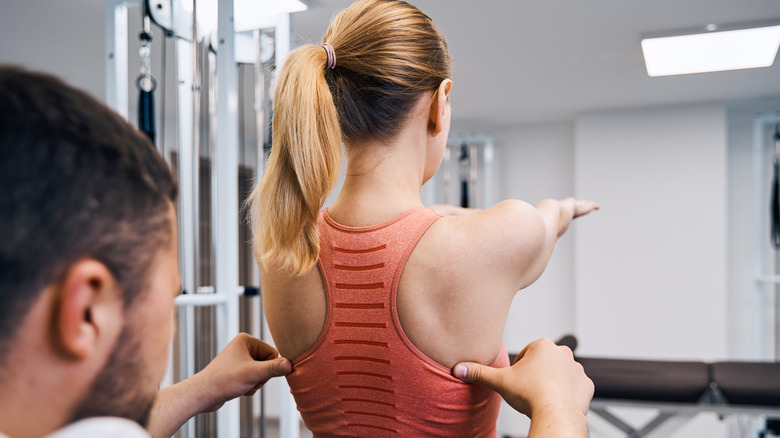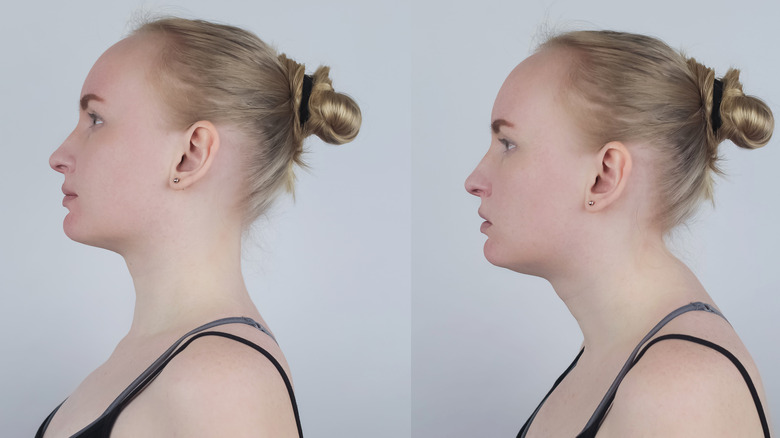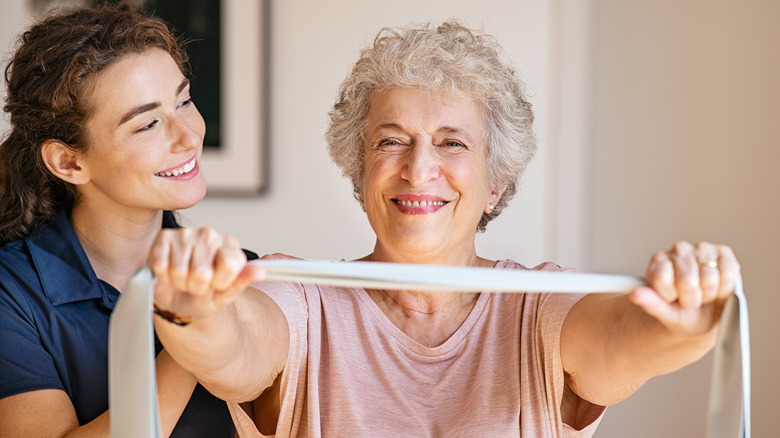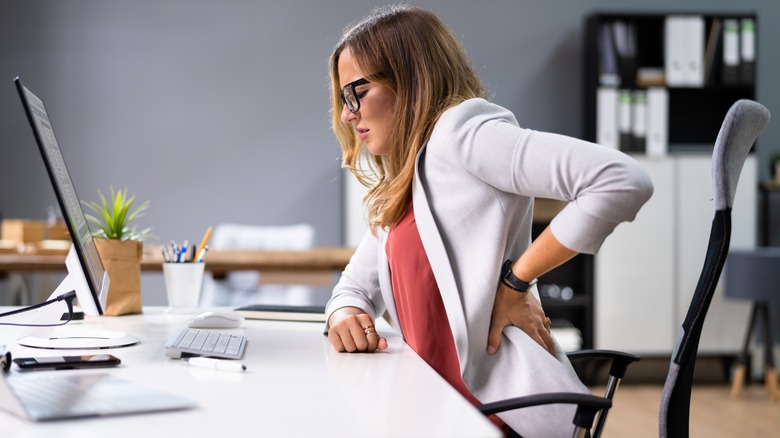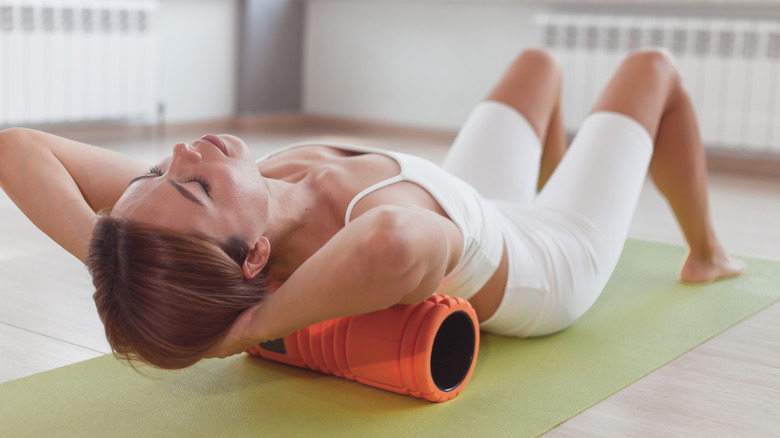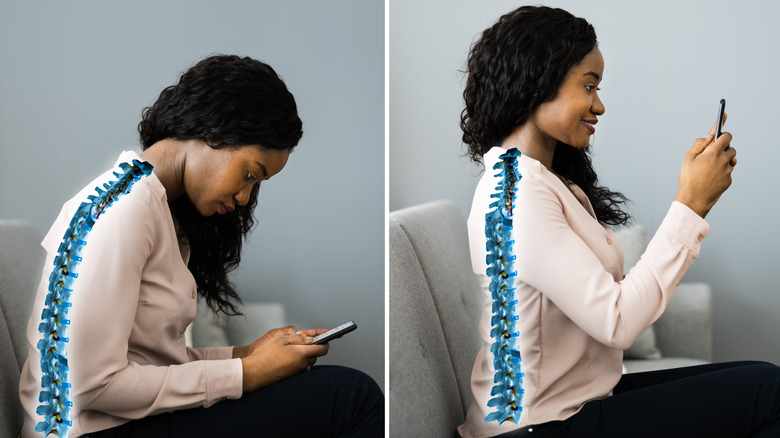How Neck Hump Exercises Can Help Perfect Your Posture
We may receive a commission on purchases made from links.
Do you often find yourself in less-than-ideal postures and internally panic about the long-term effects it could have? You're not alone. It's too easy to slip into bad posture when doing routine tasks like working at a desk or reading a book. Bad posture has short and long-term effects and can even cause a neck hump, also known as a dowager's hump.
A neck hump is characterized by a curvature of the thoracic spine, the upper part of the spine. This medical condition is known by many names, including hunchback, hyperkyphosis, and kyphosis. People with this condition appear slouched forward with rounded shoulders and a visible bump beneath their jaws. It's important to note that poor posture isn't the only cause of neck humps. A 2010 study published in the Journal of Orthopaedic & Sports Physical Therapy states that neck humps can be caused by disc disease, muscle weakness, and vertebral fractures.
Another 2020 study published in the Journal of Campbell Systematic Reviews says that the condition could even be caused by genetics. Luckily, neck humps, like bad posture, can be treated by exercise. Neck hump exercises are designed to perfect posture by strengthening, stretching, and realigning the spine. This makes them applicable to anyone looking to fix their posture, regardless of whether or not they have a hump.
Chin tucks
Chin tucks are one of the best exercises that can help you fix bad posture because you can do them while sitting at your desk or standing. To begin, sit or stand in an upright position with good posture. This means keeping your shoulders back and your head in line with your body. If you're standing, align your feet with your shoulders and keep your knees free.
After attaining good posture, slightly suck in your belly to eliminate any slouch. This position will stretch your spine, but you should still be relatively comfortable. Next, pull your head straight back until you almost look like you're forming a double chin. Then tuck your jaw inside to amplify that double chin. You can place two fingers on your jaw to help you tuck it in properly. If you have proper placement, your ears will be aligned with your shoulders.
The last step is to stretch your spine by enforcing an upright position for two seconds before letting go. Chin tucks are perfect for neck humps and poor posture because they stretch the back and shoulders while strengthening the front neck muscles. What's more? They can realign the head, cervical, and thoracic spine if done consistently. To get the most from this exercise, do it twice daily, performing ten repetitions each time.
Shoulder blade retractions
Shoulder blade retractions, also known as scapular retractions, can be performed sitting, standing, or lying on your belly. These exercises improve posture by strengthening and stretching the scapular muscles. To perform a sitting scapular retraction, you'd need an exercise band. Start by sitting in an upright position while maintaining good posture. Next, grasp the resistance band in both hands and straighten your arms. They should be at the length of your shoulders, with the resistance band held taut between both arms.
You should ensure that your shoulders aren't tense but relaxed. Next, squeeze your shoulder blades together and hold them there for five seconds. The resistance band will create tension which will help strengthen your upper and middle back muscles while improving your stance and posture. Don't worry if you don't have a resistance band because they're really affordable. You can get a pack of 5 resistance bands with different resistance levels and a carrier bag for less than $10 on Amazon.
If you'd like to perform scapular retractions without resistance bands, hold the squeeze for five seconds. This will strengthen your upper back muscles and also improve your posture. Shoulder blade retractions without an exercise band aren't as effective but can provide visible results if done in sets of ten multiple times a day. With a resistance band, a twice-daily routine is sufficient.
Doorway pec stretches
As you've probably guessed, doorway pec stretches involve stretching your shoulders and chest using a doorway. How? Start by standing in front of a doorway — not a shut door. It needs to be open so you can rest your palm and forearm (from your wrist to your elbow) on the doorway. Ensure that your elbows are at the same height as your shoulders. Do this with both arms and get a steady grip because you'll need to retain your hold through the rest of the steps.
Next, step out of the door with one leg, leaning into the step to stretch your chest and shoulders. Hold this position for 20 to 30 seconds before repeating the steps with your other leg. Repeat this set four to five times. Doorway pec stretches are one of the best stretches to relieve shoulder pain and reposition your shoulders. They improve posture and relieve tension caused by long hours of computer-centered work and lengthy drives.
In addition, the Government of Alberta recommends doorway stretches if you're in a wheelchair and want to relieve your chest muscles. First, set your chair in front of the doorway and then lock it in place. Next, position your forearm and palm on the doorway and lean your right shoulder forward. Hold this position for 15 to 30 seconds and do this four times with each shoulder. This exercise should stretch your muscles without pain, so if it hurts, stop immediately.
Thoracic extensions with a foam roller
Thoracic extensions affect the upper back from the rib cage's base to the neck's bottom. These exercises stretch the spine, which helps restore its natural curve, relieve tightness, and correct posture. There are various thoracic extension exercises, but one of the most effective types requires a foam roller. If you don't have one, you can get a Yes4All High-Density 12-inch foam roller for less than $10 on Amazon.
To begin, sit on a non-slip surface and place your foam roller behind you, leaving only a little space between your back and the roller. Next, lean back on the roller and adjust its placement, so it is at your lower rib cage. Keep your knees bent with your feet and butt on the floor. You want to create a triangle between your thigh, leg, and the ground. Next, use your hands to support your head as you would doing sit-ups.
The next part is tricky: you want to bend over the foam roller without shooting your rib cage or neck out. When you extend yourself over the roller, most of the movement should come from your upper back. Once you extend yourself three times, slide your feet and butt down, so the roller is just below your armpits. Repeat the extensions thrice before sliding again to move the roller right under your armpits. Do the set thrice again before sliding, so the roller is right under your upper shoulder blades. Repeat the extension three times, and you're done!
Wall angels
Wall angels are one of the best neck stretches to give you instant pain relief. They also correct neck humps and fix your posture. To begin, rest your butt against a wall with your feet a few inches away from the wall. Bend your knees slightly and flatten your entire back against the wall. If you have a bad posture, you might find it challenging to do this. One easy hack is to take a deep breath and let it go, which will help you relax against the wall.
The next step is to flatten the back of your head against the wall so that your gaze is set straight instead of upwards. Hold this position and lay your arms by your side. The space between your body and arms should create a triangular shape. Finally, ensure your knuckles are flat against the wall without shrugging your shoulders. Congratulations! You've done the wall angel. Hold this position for 20 to 30 seconds each time to get maximum benefits.
One last thing to note is it's equally important to make a habit of assessing your posture as you perform daily tasks. This is because poor posture can undo all the exercising benefits. For example, if you spend long hours on your mobile phone or working at your laptop, ensure you're sitting upright. Lastly, walk with your head high and chest out. Not only does this put less strain on your spine, but it also portrays self-confidence and competence.
